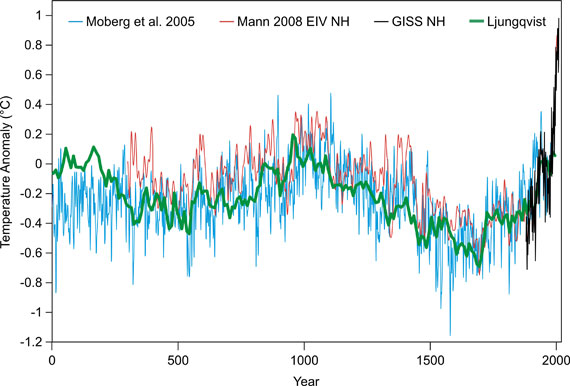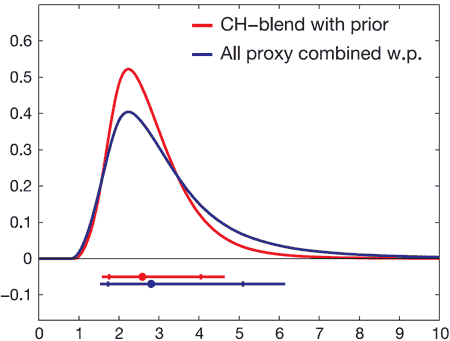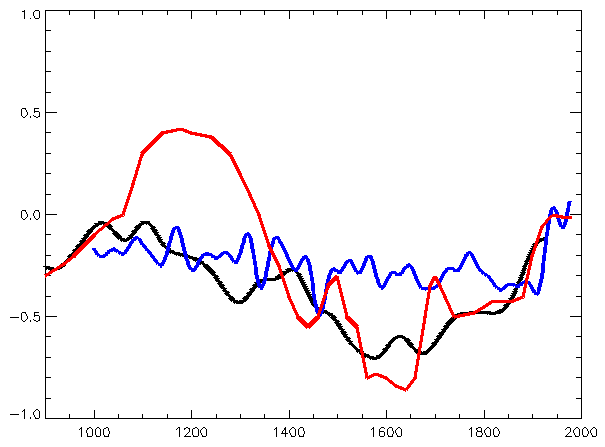Hockey Stick Own Goal
Posted on 23 February 2011 by dana1981
 In this post we continue our Prudent Path Week theme, and the examination of the two documents the "skeptics" referenced in their recent letter to Congress — 'Carbon Dioxide and Earth's Future: Pursuing the Prudent Path' and the NIPCC report. Specifically, we examine a major contradiction between the two reports regarding a key factor in climate science - climate sensitivity.
In this post we continue our Prudent Path Week theme, and the examination of the two documents the "skeptics" referenced in their recent letter to Congress — 'Carbon Dioxide and Earth's Future: Pursuing the Prudent Path' and the NIPCC report. Specifically, we examine a major contradiction between the two reports regarding a key factor in climate science - climate sensitivity.
Medieval vs. Current Global Temperature
In their Prudent Path document, Craig and Sherwood Idso argue that the Medieval Warm Period (MWP) was at least as hot as today.
"it was just as warm as, or even warmer than, it has been recently during both the Roman and Medieval Warm Periods"
Informal Idsos
The document spends several pages qualitatively discussing various temperature proxy data sets from various isolated geographic locations — one of the main pursuits of the Idsos' website co2science.org. The only response this endeavor warrants is the suggestion that if the Idsos would like to attempt to use this data to demonstrate that the MWP was hotter than today, they should perform a quantitative assessment — combine these proxies into either a northern hemisphere or global data set, estimate the average temperature, and submit their results to a peer-reviewed scientific journal. Over a dozen such millennial northern hemisphere reconstructions have been peer-reviewed, and all agree that current temperatures are hotter than during the MWP peak.
Ljungqvist (2010)
The document also relies fairly heavily on one such millennial northern hemisphere reconstruction — Ljungqvist (2010) — which the Idsos refer to as a "stellar effort". However, this reconstruction is not substantially different from the many other millennial northern hemisphere temperature reconstructions, as Ljungqvist himself states in his paper:
“Our temperature reconstruction agrees well with the reconstructions by Moberg et al. (2005) and Mann et al. (2008) with regard to the amplitude of the variability as well as the timing of warm and cold periods, except for the period c. AD 300–800, despite significant differences in both data coverage and methodology.”
Contrary to the Idsos' claims in the Prudent Path document, Ljungqvist says the following when combining his proxy reconstruction with recent instrumental temperature data:
“Since AD 1990, though, average temperatures in the extra-tropical Northern Hemisphere exceed those of any other warm decades the last two millennia, even the peak of the Medieval Warm Period”
Indeed by plotting Ljungqvist's data along with Moberg et al. (2005), Mann et al. (2008), and the surface temperature record, we can confirm that the three reconstructions are very similar, and all show the peak of the MWP approximately 0.5°C cooler than today's temperatures (Figure 1).

Figure 1: Moberg et al. 2005 NH (blue), Mann et al. 2008 EIV NH (red), Ljungqvist 2010 NH (green), and GISS land+ocean NH (black). Courtesy of Robert Way and John Cook.
Thus we can see that the Prudent Path document's own references do not support its claim that the MWP peak was as hot or hotter than today's temperatures. This is a good thing, because the larger past natural temperature changes were, the larger the climate sensitivity.
Skeptic Climate Sensitivity Contradiction
A quick perusal through the Skeptical Science rebuttal database makes it clear that "skeptic" arguments often contradict each other. Perhaps the worst contradiction of them all are the conflicting claims that the MWP was hotter than today, and that climate sensitivity is low.
Skepticism Requires Low Climate Sensitivity
Climate sensitivity (the amount the planet's average surface temperature will warm given a certain energy imbalance, including feedbacks) is the key to global warming skepticism. The amount of warming at the Earth's surface depends on two factors — the size of the energy imbalance, and the climate sensitivity to that energy. However, the first factor (the energy imbalance caused by the increase in greenhouse gases) is a well-measured and well-known quantity.
Therefore, the only way to argue that humans aren’t driving global temperatures now, and temperature change over the next century won’t be potentially catastrophic in a business-as-usual scenario, is if climate sensitivity is low. "Skeptic" climate scientists like Lindzen, Spencer, and Christy realize this, and it's why their arguments consistently center around the argument "climate sensitivity is low".
The heat trapped by the increased atmospheric CO2 has to go somewhere, and the only way it's not causing and will not cause significant global warming and climate change in the future is if it's suppressed by cooling effects from negative feedbacks. If this were the case, climate sensitivity would be low. And this is indeed a key argument made in the NIPCC report:
"Scientific research suggests the model-derived temperature sensitivity of the earth accepted by the IPCC is too large. Corrected feedbacks in the climate system could reduce climate sensitivity to values that are an order of magnitude smaller."
The NIPCC report is claiming that the IPCC sensitivity range is too high by a factor of 10, but the Idso Prudent Path document, by claiming that the MWP was as hot or hotter than today, is arguing that the IPCC sensitivity range is too low.
Hot MWP Means High Sensitivity
As John Cook has previously discussed, arguing for large swings in natural temperature variation such as a particularly hot MWP is akin to arguing for high climate sensitivity. Several scientific studies have examined the radiative forcings and temperature changes over the past millennium, such as Hegerl et al 2006, as shown in Figure 2:

When you combine the temperature record over the past millennium with climate forcings, you get a most likely climate sensitivity value close to 3°C, consistent with the IPCC climate sensitivity range of 2°C to 4.5°C. So if the temperature swings were actually larger than in the reconstructions used by Hegerl and other studies on millennial climate sensitivity, it means the climate sensitivity is actually higher than the IPCC has concluded.
The two documents referenced in the "skeptic" letter to Congress blatantly contradict each other on this issue. The NIPCC report argues that the climate sensitivity is an order of magnitude lower than the IPCC range, while the Idso Prudent Path document indirectly argues that the sensitivity is higher than the IPCC range. On the most important issue for climate "skeptics" — climate sensitivity — the two documents cited in the "skeptic" letter to Congress contradict each other by a factor of ten.
The True Prudent Path
Ironically, although the two "skeptic" documents differ on the climate sensitivity parameter by an order of magnitude, both are wrong. There are many independent lines of evidence behind the IPCC climate sensitivity range, meaning that it's exceptionally unlikely that it's wrong by an order of magnitude, as the NIPCC report claims. And as discussed above, the evidence does not support the Idso claim that the MWP peak was as hot or hotter than today.
Thus the real "prudent path" involves proceeding under the assumption that the well-supported IPCC likely range of climate sensitivity (2 to 4.5°C with a most likely value of 3°C warming for a doubling of atmospheric CO2) is correct. In this scenario, we are heading towards extremely dangerous and potentially catastrophic warming and climate change this century in a business-as-usual scenario.
Thus the true prudent path involves taking immediate action to significantly reduce human CO2 emissions. If the "skeptics" want to convince us otherwise, they need to start by getting their story straight.
This post was written by Dana Nuccitelli (dana1981) and has been developed into the Intermediate rebuttal to "Ljungqvist broke the hockey stick"































 Arguments
Arguments























 0
0  0
0 On a separate note, why on earth would you want to exclude the marked warming over the Arctic? Ignoring polar amplification won't make it go away.
On a separate note, why on earth would you want to exclude the marked warming over the Arctic? Ignoring polar amplification won't make it go away.
 As you do not like GISStemp, I consulted HadCRUT3:
As you do not like GISStemp, I consulted HadCRUT3:
 That shows approximately a 0.27 degree rise from 1979 to 2008 in global mean temperature, which as you know was anomalously cold for the 21st century. A better comparison is with Northern Hemisphere temperatures, which Moberg et al reconstructed. HadCRUt3nh shows nearly 0.5 degrees increase over 1976 for 2008, again an anomalously cold year.
For comparison, the MWP in Moberg et al averages around 1970 temperatures or lower, although just four years (1016, 1017, 1105 and 1106) rise to near 2008 levels, with the highest (1105 at 0.3717) being 0.43 degrees warmer than 1979, and hence cooler than the, cool for the 21st century, 2008 in the NH.
In this case, it is you who are trying to hide things on the spaghetti graph.
With regard to GISS temperatures, you are again wrong. First, deniers often claim that the GISS reconstruction of temperatures in the arctic circle are based on only a very few stations because only a very few such stations lie within the arctic circle itself. This deliberately - deceitfully - ignores the significant number of stations lying just outside the arctic circle but well within the range of the arctic circle for GISS's temperature reconstruction.
However, evidence does suggest that there is a problem with the GISS temperature reconstruction. Comparison with the DMI arctic temperature reconstruction shows that the use of stations outside the arctic circle to help reconstruct temperatures within in it has resulted in GISStemp underestimating the warming trend in the arctic by about 0.2 degrees per decade.
That shows approximately a 0.27 degree rise from 1979 to 2008 in global mean temperature, which as you know was anomalously cold for the 21st century. A better comparison is with Northern Hemisphere temperatures, which Moberg et al reconstructed. HadCRUt3nh shows nearly 0.5 degrees increase over 1976 for 2008, again an anomalously cold year.
For comparison, the MWP in Moberg et al averages around 1970 temperatures or lower, although just four years (1016, 1017, 1105 and 1106) rise to near 2008 levels, with the highest (1105 at 0.3717) being 0.43 degrees warmer than 1979, and hence cooler than the, cool for the 21st century, 2008 in the NH.
In this case, it is you who are trying to hide things on the spaghetti graph.
With regard to GISS temperatures, you are again wrong. First, deniers often claim that the GISS reconstruction of temperatures in the arctic circle are based on only a very few stations because only a very few such stations lie within the arctic circle itself. This deliberately - deceitfully - ignores the significant number of stations lying just outside the arctic circle but well within the range of the arctic circle for GISS's temperature reconstruction.
However, evidence does suggest that there is a problem with the GISS temperature reconstruction. Comparison with the DMI arctic temperature reconstruction shows that the use of stations outside the arctic circle to help reconstruct temperatures within in it has resulted in GISStemp underestimating the warming trend in the arctic by about 0.2 degrees per decade.
 What looks like a hockey stick is Mann et al 1998 (you can also see from table 2 in the Ljungqvist PDF that Mann 2003 also fails to capture this variability)
What looks like a hockey stick is Mann et al 1998 (you can also see from table 2 in the Ljungqvist PDF that Mann 2003 also fails to capture this variability)
 So can we just nail this. The reconstructions that were so critically used by the IPCC are these earlier Mann reconstructions and if you are now accepting Fig1 as the correct reconstructions then it looks like the critics were right to highlight this problem. So would you be supportive of ClimateAudits attempts to highlight this problem early on?
So can we just nail this. The reconstructions that were so critically used by the IPCC are these earlier Mann reconstructions and if you are now accepting Fig1 as the correct reconstructions then it looks like the critics were right to highlight this problem. So would you be supportive of ClimateAudits attempts to highlight this problem early on?
 The two curves differ for the period 1600-1700 and at the very beginning of Mann's curve. Was that the big problem highlighted by ClimateAudit?
The two curves differ for the period 1600-1700 and at the very beginning of Mann's curve. Was that the big problem highlighted by ClimateAudit?
 It is very clear that Moberg 2005 matches much better with MBH 99 than with IPCC 1990, particularly during the MWP. MBH 99 clearly understates the LIA, although the extent to which they do may be exaggerated in this graph in that Moberg 2005 shows a much cooler LIA than most modern reconstructions.
So, it is clear that MBH 99 (and 98) are a major advance over IPCC 1990. Since then statistical techniques in reconstructions have improved so that there are several reconstructions that give better results than MBH 99, and are consequently preferred. Stuck in a time warp, deniers are still using IPCC 1990 and attacking MBH 98 as if that somehow undermines modern reconstructions.
As to M&M's particular criticisms of MBH 98, many of them are simply wrong, and the rest much over exaggerated in their effect on the reconstruction. I do not think it is good science to be merely political attack dogs trying to pick up any flaws on papers whose conclusions you dislike while giving a free pass to papers whose conclusions you do like. The complete hypocrisy of M&M is shown by the complete pass they give to IPCC 1990 compared to the fine tooth comb they run through MBH 98.
It is very clear that Moberg 2005 matches much better with MBH 99 than with IPCC 1990, particularly during the MWP. MBH 99 clearly understates the LIA, although the extent to which they do may be exaggerated in this graph in that Moberg 2005 shows a much cooler LIA than most modern reconstructions.
So, it is clear that MBH 99 (and 98) are a major advance over IPCC 1990. Since then statistical techniques in reconstructions have improved so that there are several reconstructions that give better results than MBH 99, and are consequently preferred. Stuck in a time warp, deniers are still using IPCC 1990 and attacking MBH 98 as if that somehow undermines modern reconstructions.
As to M&M's particular criticisms of MBH 98, many of them are simply wrong, and the rest much over exaggerated in their effect on the reconstruction. I do not think it is good science to be merely political attack dogs trying to pick up any flaws on papers whose conclusions you dislike while giving a free pass to papers whose conclusions you do like. The complete hypocrisy of M&M is shown by the complete pass they give to IPCC 1990 compared to the fine tooth comb they run through MBH 98.
 -- Chap 6 Paleoclimate, Figure 6-10b
Perhaps showing that our understanding has evolved. That's what science does.
BTW, that's another figure showing at least 1 degree of warming since 1910.
-- Chap 6 Paleoclimate, Figure 6-10b
Perhaps showing that our understanding has evolved. That's what science does.
BTW, that's another figure showing at least 1 degree of warming since 1910.







Comments